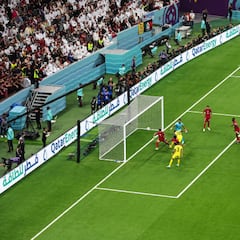The handball rule in soccer explained: Why is it only sometimes a foul?
What are the penalties and the consequences in the game when a football player during the action breaks the handball rule in soccer, explained.


The handball rules in soccer are among the game’s most contested and vague laws. Below you can get familiar more with its most essential aspects. Handball is an important rule for the game of soccer, and it differentiates it from many other sports and is one of the most significant impacts on how the game is run.
In a nutshell, a handball in football is when the ball makes contact with a player’s hand/arm illegally.
World Cup news:
- Mané and Salah complicate Pelé's dire prediction
- Captain America
- England players take the knee... for three seconds
Where does the arm start/end?
The arm commences from the bottom of the armpit, implying that the ball causing contact with the shoulder is not considered a handball. It can sometimes be ambiguous whether the ball has touched the arm or shoulder of the player, which gets us to the arbitrary essence of the handball rules in soccer in general.
It’s up to the referee to decide if it’s a foul if the ball hits this area. In general, the referee will look at the closeness between the player and the ball and the initial position of the hand/arm whenever handball contact is made. If the proximity is very close, giving the player little chance to react, that might overrule the handball offense.
A lot of aspects are concerned when summoning a potential handball offense. Due to its influence on the game, VAR can only be used in decisive defensive and attacking scenarios.
Handballs in defensive scenarios
We frequently see players fold their arms behind the back or in the sides of the body, in a so-called “natural position” when defending near an attacker’s cross or shot.
It is usually a handball if:
- The ball touches the arm, or the hand is extended in an unnatural position.
EXPLANATION: An arm extended laterally or vertically can make the body unnaturally bigger, covering more space than necessary. Consequently, a handball in an “unnatural position” can be called, even if it is not done deliberately.
It is usually not a handball if:
- The ball makes contact with the arm/hand in a “natural position.”
- The ball accidentally makes contact with a defender’s hand/arm inside their penalty area from a deflection, a teammate’s clearance, or similar.
- The ball makes contact with a player’s supporting arm/hand. A player who falls to the ground or goes into a sliding tackle must protect himself using the arm’s support. Therefore it is usually not a handball if the ball hits the supporting arm/hand. On the contrary, it can lead to a handball situation if a player goes into a sliding tackle with his arm extended without using it as support.
Handballs in attacking scenarios
No goals can be scored with the arm or hand, even if accidental. Therefore the handball rules in football are more strict in attacking scenarios.
It is usually a handball if:
- A goal is scored by the arm/hand of an attacking player; or if the ball touches an attacking player’s hand/arm in the immediate goal-scoring build-up play. A handball can be called if the arm/hand gives the player an unfair advantage. Even if the attacker’s arms were close to the body in a “natural position.”
Handball offenses
Related stories
As the understanding of handball, incidents have not always been agreed upon due to inaccurate applications or interpretations of the Law. With the latest rule change confirming that not every touch of a player’s hand/arm with the ball is an offense, the idea is to change it.
As we said earlier, most handball punishments are at the referee’s discretion. However, there are some guidelines for specific incidents:
- A handball will not be penalized if it is an instance such as any of the scenarios mentioned above
- A standard handball foul during a game is generally punished with a free-kick or penalty being awarded
- A yellow card may be given to the handball offender if the foul is considered more cynical or worse than a standard handball. However, this is at the discretion of the referee.
- A red card is awarded for handball if the offense prevents a clear goal-scoring chance. A player may also be given a red card if they receive a second yellow card for a handball.

